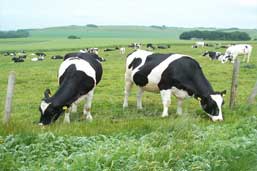Cow Facts
The Holstein cow is quickly recognised by their distinctive colour markings and outstanding milk production.
Holsteins are large cattle with coat colour patterns of black and white or red and white. The main function of a dairy cow
is to produce milk. In the UK and many countries across the world, the Holstein is the predominant breed because of its
ability to produce high volumes of milk efficiently.

The Holstein breed currently averages 7330 litres/year with pedigree animals averaging 8600 litres/lactation over an average
of 3 lactations.
In addition to the Holstein, the British Friesian has developed along slightly different lines and remains a dual-purpose
animal with the potential to produce substantial volumes of milk and produce male calves that can be fattened up to produce
quality beef. British Friesian cattle are generally slightly smaller than Holsteins and carry more flesh. The average milk
production of pedigree British Friesians currently stands at 6020 litres/year compared to a lactation average of 6620
litres/lactation over 3.6 lactations.
The black and white Holstein and British Friesian breeds originate in Western Europe, in particular Holland and North
Germany. The British Friesian became established in the UK during the Nineteenth Century, particularly in the eastern and
home counties and southern Scotland. The first Herd Book was founded in 1909. The Holstein as we know today was first
established in North America starting with an imported bull and 4 heifers from Holland into the United States in the 1850s.
The breed first appeared in the UK in the years immediately after the Second World War, during which time around 2000
in-calf heifers plus a few bulls and cows were imported from Canada in conjunction with shiploads of store cattle.
|
Calf Facts
Calves can be born throughout the year. When the calf has been born, the mother licks it to remove the birth fluids.
The calf is normally able to stand within a few hours of birth and will drink Colostrum from the cow’s udder. Colostrum
is a type of milk which the cow produces for the first 24 hours or so after giving birth; it protects the new-born calf
from disease and provides vital anti-bodies.
In modern farming systems the calf is taken from its mother within a couple of days as she is needed to produce milk for
sale. The farmer feeds the calf milk from a bucket for the next 6-8 weeks until it is weaned.
The calf must, by law, be identified with two tags which are inserted into each ear shortly after birth. Calves may be
dehorned when they are a few weeks old. This procedure does not hurt the calf but stops the horns from developing and
causing possible injury to other animals or humans.
Heifer (female) calves usually stay on the farm and are reared for entry into the milking portion of the herd whereas
bull (male) calves are usually reared for beef. In exceptional cases where the bull is of superior genetic merit, it may
be used for breeding.
Milking Facts
Before a heifer can produce milk she must have a calf. Heifers are mated at 15-21 months old. Artificial insemination is
the usual method although natural service may be used. Usually, the heifer will be pregnant for nine months before giving
birth. Once the heifer has given birth she will begin to produce milk. She will be called a heifer until she has her second
calf when she will be called a cow. Milk is removed from the heifer using an electricity-powered milking machine which
mimics the natural sucking action of the calf. The milking machine has a ‘cluster’ of four rubber cups which are attached to
the heifer’s four teats. Gentle suction is applied to the teats and the milk is drained into a system of pipes leading to a
refrigerated tank where the milk is stored until it is collected by a tanker, usually once a day. The herd is usually milked
twice a day, with some farms milking three times a day.
Calving Facts
Ideally the cow should calve once a year. Due to the gestation period of nine months, the cow needs to be mated three months
after she had her last calf. The cow continues to produce milk throughout most of her pregnancy until about three months
before she is due to calve when she is ‘dried off’ meaning the farmer stops milking her. This allows her to rest and be
ready for her next lactation. The lactation period lasts for approximately 305 days.
Feeding Facts
For milk production, the cow must eat large quantities of food and drink large volumes of water to obtain the nutrients that she needs.
The cow is a ruminant which means that, unlike humans, she can make use of fibrous foods such as grass. In the UK, most grass grows in the
months between March and November. The herd grazes outside during this period. Surplus grass is preserved for the winter months. The most
common form of preservation is in the form of silage which is fermented grass. Drying grass in the sun is another method of preservation
which produces hay. In recent years, farmers in central and southern Britain have started growing maize (the same plant as sweetcorn) to
make into silage as well, providing extra protein to the cows’ diet. Cows will eat silage or hay in the period between October and April
when they are kept indoors.
Expectations of the modern dairy cow is a high milk production level, therefore, her grass-based diet needs to be
supplemented with extra energy, protein, vitamins and minerals. Concentrates are used for this purpose. Concentrates are
mixtures of cereals, rape meal, sunflower meal, peas, soya, vitamins, and minerals etc which are ground and pressed in
animal feed manufacturing mills to produce small, brown pellets.
|